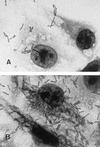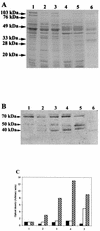Clostridium difficile cell attachment is modified by environmental factors
- PMID: 10473442
- PMCID: PMC99767
- DOI: 10.1128/AEM.65.9.4234-4238.1999
Clostridium difficile cell attachment is modified by environmental factors
Abstract
Adherence of Clostridium difficile to Vero cells under anaerobic conditions was increased by a high sodium concentration, calcium-rich medium, an acidic pH, and iron starvation. The level of adhesion of nontoxigenic strains was comparable to that of toxigenic strains. Depending on the bacterial culture conditions, Vero cells could bind to one, two, or three bacterial surface proteins with molecular masses of 70, 50, and 40 kDa.
Figures




Similar articles
-
Tolevamer, an anionic polymer, neutralizes toxins produced by the BI/027 strains of Clostridium difficile.Antimicrob Agents Chemother. 2008 Jun;52(6):2190-5. doi: 10.1128/AAC.00041-08. Epub 2008 Apr 7. Antimicrob Agents Chemother. 2008. PMID: 18391047 Free PMC article.
-
Drivers of Clostridioides difficile hypervirulent ribotype 027 spore germination, vegetative cell growth and toxin production in vitro.Clin Microbiol Infect. 2020 Jul;26(7):941.e1-941.e7. doi: 10.1016/j.cmi.2019.11.004. Epub 2019 Nov 9. Clin Microbiol Infect. 2020. PMID: 31715298
-
Development and evaluation of a PCR method for detection of the Clostridium difficile toxin B gene in stool specimens.J Clin Microbiol. 2002 Jun;40(6):2288-90. doi: 10.1128/JCM.40.6.2288-2290.2002. J Clin Microbiol. 2002. PMID: 12037113 Free PMC article.
-
Rapid detection of Clostridium difficile toxins and laboratory diagnosis of Clostridium difficile infections.Infection. 2017 Jun;45(3):255-262. doi: 10.1007/s15010-016-0940-9. Epub 2016 Sep 6. Infection. 2017. PMID: 27601055 Review.
-
Prevalence of Detection of Clostridioides difficile Among Asymptomatic Children: A Systematic Review and Meta-analysis.JAMA Pediatr. 2021 Oct 1;175(10):e212328. doi: 10.1001/jamapediatrics.2021.2328. Epub 2021 Oct 4. JAMA Pediatr. 2021. PMID: 34338715 Free PMC article.
Cited by
-
Molecular characterization of fliD gene encoding flagellar cap and its expression among Clostridium difficile isolates from different serogroups.J Clin Microbiol. 2001 Mar;39(3):1178-83. doi: 10.1128/JCM.39.3.1178-1183.2001. J Clin Microbiol. 2001. PMID: 11230454 Free PMC article.
-
Gene targets for engineering osmotolerance in Caldicellulosiruptor bescii.Biotechnol Biofuels. 2020 Mar 13;13:50. doi: 10.1186/s13068-020-01690-3. eCollection 2020. Biotechnol Biofuels. 2020. PMID: 32190115 Free PMC article.
-
Molecular and genomic analysis of genes encoding surface-anchored proteins from Clostridium difficile.Infect Immun. 2001 May;69(5):3442-6. doi: 10.1128/IAI.69.5.3442-3446.2001. Infect Immun. 2001. PMID: 11292772 Free PMC article.
-
Differential stress transcriptome landscape of historic and recently emerged hypervirulent strains of Clostridium difficile strains determined using RNA-seq.PLoS One. 2013 Nov 7;8(11):e78489. doi: 10.1371/journal.pone.0078489. eCollection 2013. PLoS One. 2013. PMID: 24244315 Free PMC article.
-
Regulatory Role of Anti-Sigma Factor RsbW in Clostridioides difficile Stress Response, Persistence, and Infection.J Bacteriol. 2023 May 25;205(5):e0046622. doi: 10.1128/jb.00466-22. Epub 2023 Apr 26. J Bacteriol. 2023. PMID: 37098979 Free PMC article.
References
-
- Borriello S P. Clostridium difficileand its toxins in the gastrointestinal tract in health and disease. Res Clin Forums. 1979;1:33–35.
-
- Borriello S P. Pathogenesis of Clostridium difficileinfection of the gut. J Med Microbiol. 1990;33:207–215. - PubMed
-
- Borriello S P, Davies H A, Barclay F E. Detection of fimbriae amongst strains of Clostridium difficile. FEMS Microbiol Lett. 1988;49:65–67.
-
- Borriello S P, Welch A R, Barclay F E, Davies M A. Mucosal association by Clostridium difficilein the hamster gastrointestinal tract. J Med Microbiol. 1988;25:191–196. - PubMed
Publication types
MeSH terms
Substances
LinkOut - more resources
Full Text Sources
Other Literature Sources
Molecular Biology Databases

